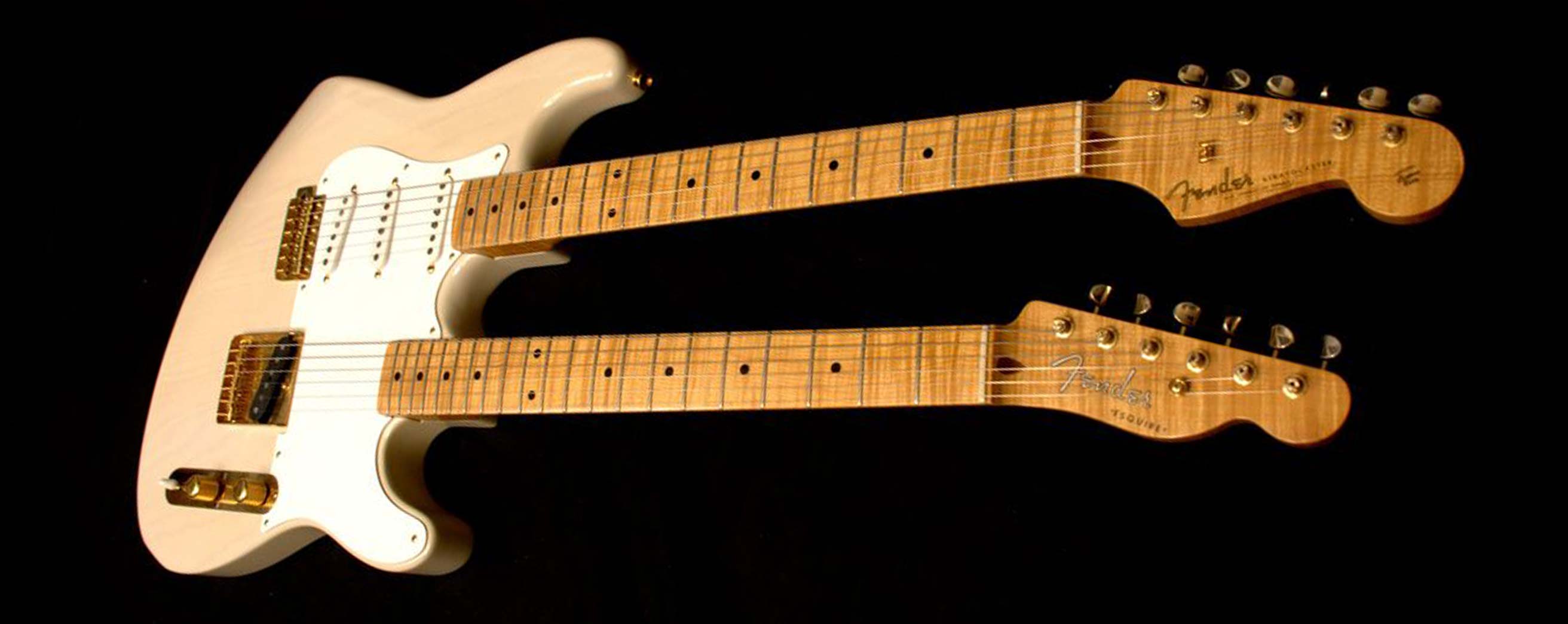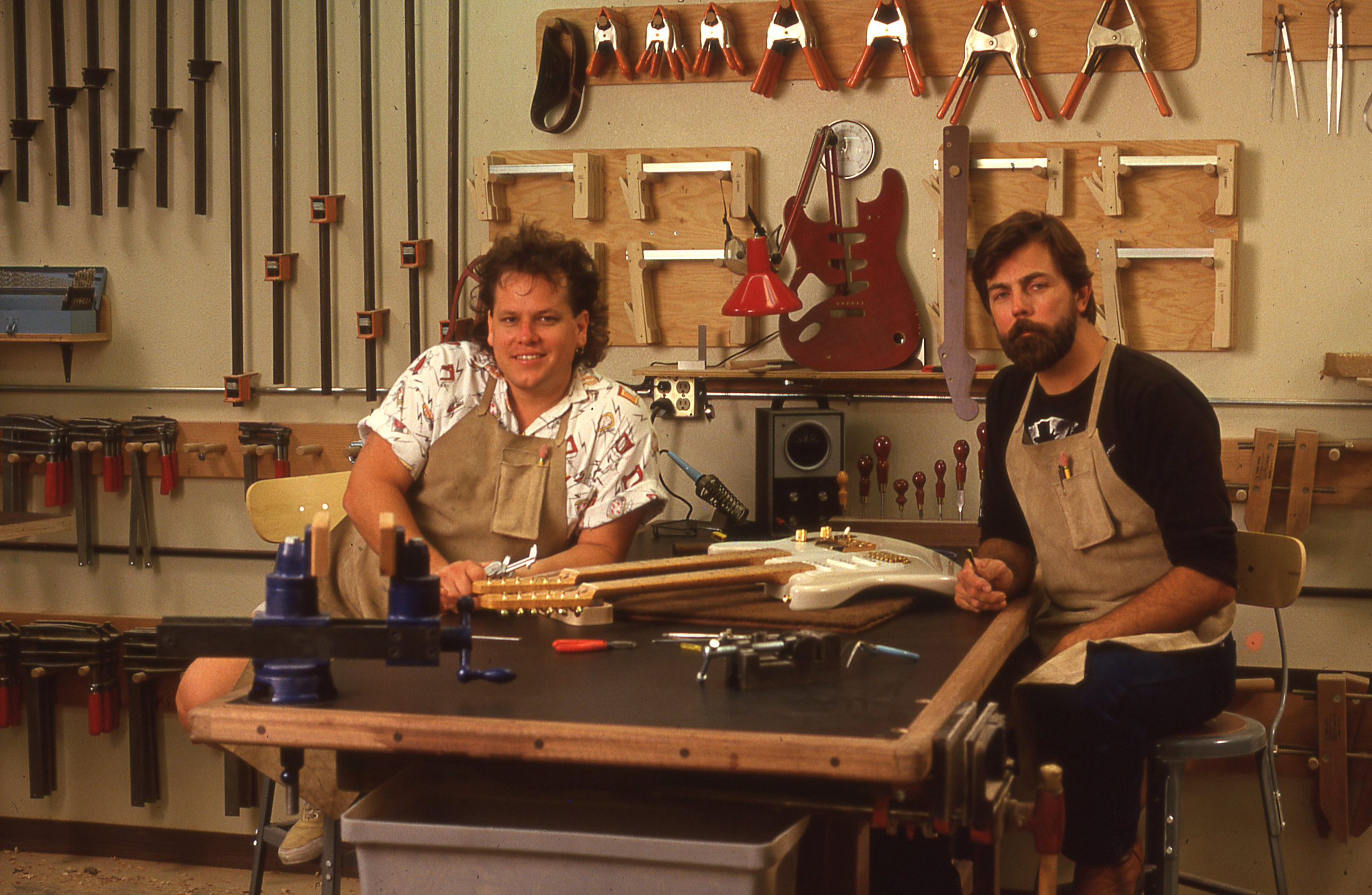3 Min ReadBy Mike Duffy
A Double-Necked Legend: The Story Behind the Custom Shop's #0001 Guitar
Original Master Builder Michael Stevens' unique Stratocaster/Esquire is widely known to be the Custom Shop's first build.

Sections
When Fender announced the 2017 Founders Design Project to celebrate the Custom Shop’s 30th anniversary, an endeavor that saw eight of the shop’s original Master Builders create their ultimate instrument, Michael Stevens came up with a breathtaking White Blonde Esquire with gold hardware.
And while this guitar is truly one-of-a-kind, its roots go all the way back to the Custom Shop’s very beginnings and the well-known double-neck Stratocaster/Esquire bearing the serial number 0001.
In 1986, in the nascent days of what has become known as the “Dream Factory”, Stevens received the Custom Shop’s first order from his friend, Jimmy Wallace, a guitarist with the band the Stratoblasters and producer of the Dallas Guitar Show and Music Festival.
Thing was, Wallace didn’t specify exactly what he wanted, allowing Stevens to build “something cool and unique.”
“I had no parameters on that guitar,” said Stevens. “The customer didn’t ask me anything, other than the number. So, I wanted to do something different.”
Something different, he did.
Stevens, who had been building guitars, basses and mandolins since 1967 when he teamed up with Larry Jameson at Guitar Resurrection in Oakland, Calif., thought hard.
He had already famously made a double-neck Strat for singer/songwriter Christopher Cross and a double-neck lap-steel/traditional guitar combo for country slinger Junior Brown.
“At that point, I’d already done a bunch of double-necks, starting with Christopher Cross,” Stevens said. “My favorite guitar in the whole world is probably the Esquire, although I don’t fault the Telecaster for having that one itty-bitty pickup in the neck.
“And the Strats, the ones we liked the best in the late ‘50s, were what’s called the ‘Mary Kaye’. When I was thinking about what to make, I wanted to combine those two.”

Michael Stevens (R) and fellow original Master Builder John Page with the double-neck Stratocaster/Esquire.
Months later, the result was Fender’s first-ever double-neck guitar (to be sold) and something truly innovative and eye-catching.
The distinctive White Blonde finish with gold hardware give it that beloved Mary Kaye look, while the instrument also boasts several interesting specifications.
On the Strat part of the body, three single-coil pickups with staggered polepieces give it that classic sound. There is also a Fender synchronized tremolo with the trem arm on the bass side. The Esquire has a single ‘50s-style flat pole pickup for more growl.
Stevens also wanted to keep the controls simple, with one volume knob and one tone knob, along with a three-way selector switch.
“I didn’t want all kind of switches,” he explained. “I hate mini-switches. They drive me nuts. So I just put on one tone control to switch between the Strat and Esquire.”
Another interesting note is that the body features the gentle curves of a Stratocaster on top and the edges of an Esquire or Telecaster on the bottom.
“I thought having it taper from the shape of a Strat on top to the Esquire shape on the bottom was pretty cool,” Stevens said. “It just gave it a great look.”
What’s more, both necks are bookmatched birdseye maple, wood Stevens had to pull from his own stash. (Bookmatching refers to matching two (or more) wood surfaces, so that two adjoining surfaces mirror each other, giving the impression of an opened book.)
“At that point, we had damn near nothing in the Custom Shop,” he laughed. “We had no inventory, but I had a big block of birdseye maple that I just split down the middle and bookmatched the fingerboards.”
When Wallace finally received the finished product in mid-1987, he knew it was special.
“It’s not just cool looking and unusual, it’s a phenomenal playing guitar,” he said in Tom Wheeler’s 2001 book The Dream Factory. “First of all, it’s not that heavy. I’ve played it on lots of gigs and it sounds amazing.”
That brings Stevens to the Founders Design Project. Having been with the Custom Shop from 1986-90, Stevens wanted to pay homage to Fender’s rich history.
“I didn’t really know what I was going to do,” Stevens said. “But then I heard them say the word ‘founders’, and I thought about the Stratocaster, the Telecaster, the Esquire. Those are the roots of Fender.”
Stevens’ Founders Design Esquire looks a lot like it’s double-necked predecessor, but with a few modifications, like a cutaway on the back for more comfort while sitting and a pickup in a left-handed bridge—reversing the traditional Telecaster orientation.
In its unfussy beauty, Stevens thinks it came out perfectly.
“This guitar is dead-on, done, perfect,” he said. “Don’t screw with it.”
Don’t miss out!
Be the first to know about new products, featured content, exclusive offers and giveaways.


